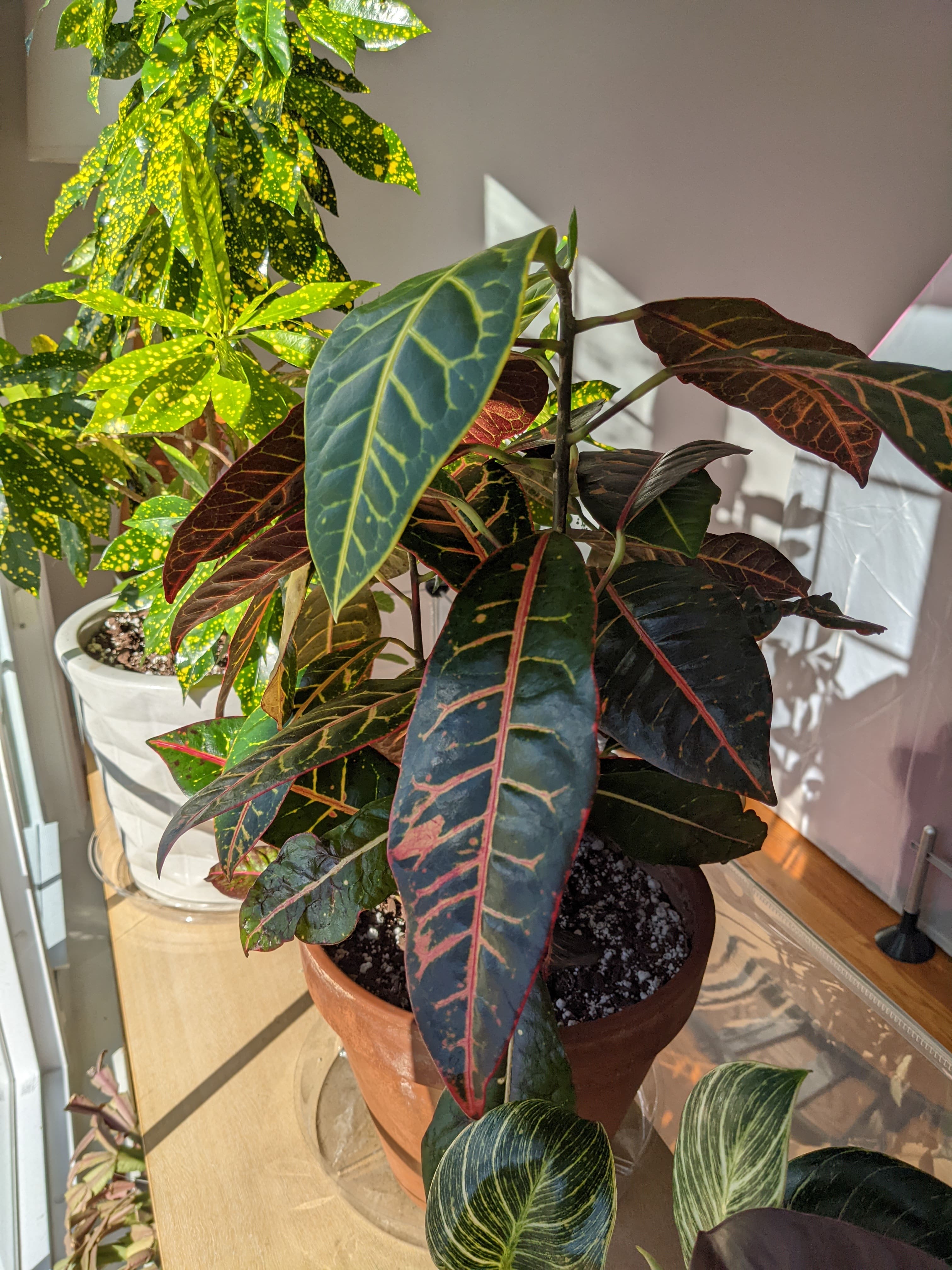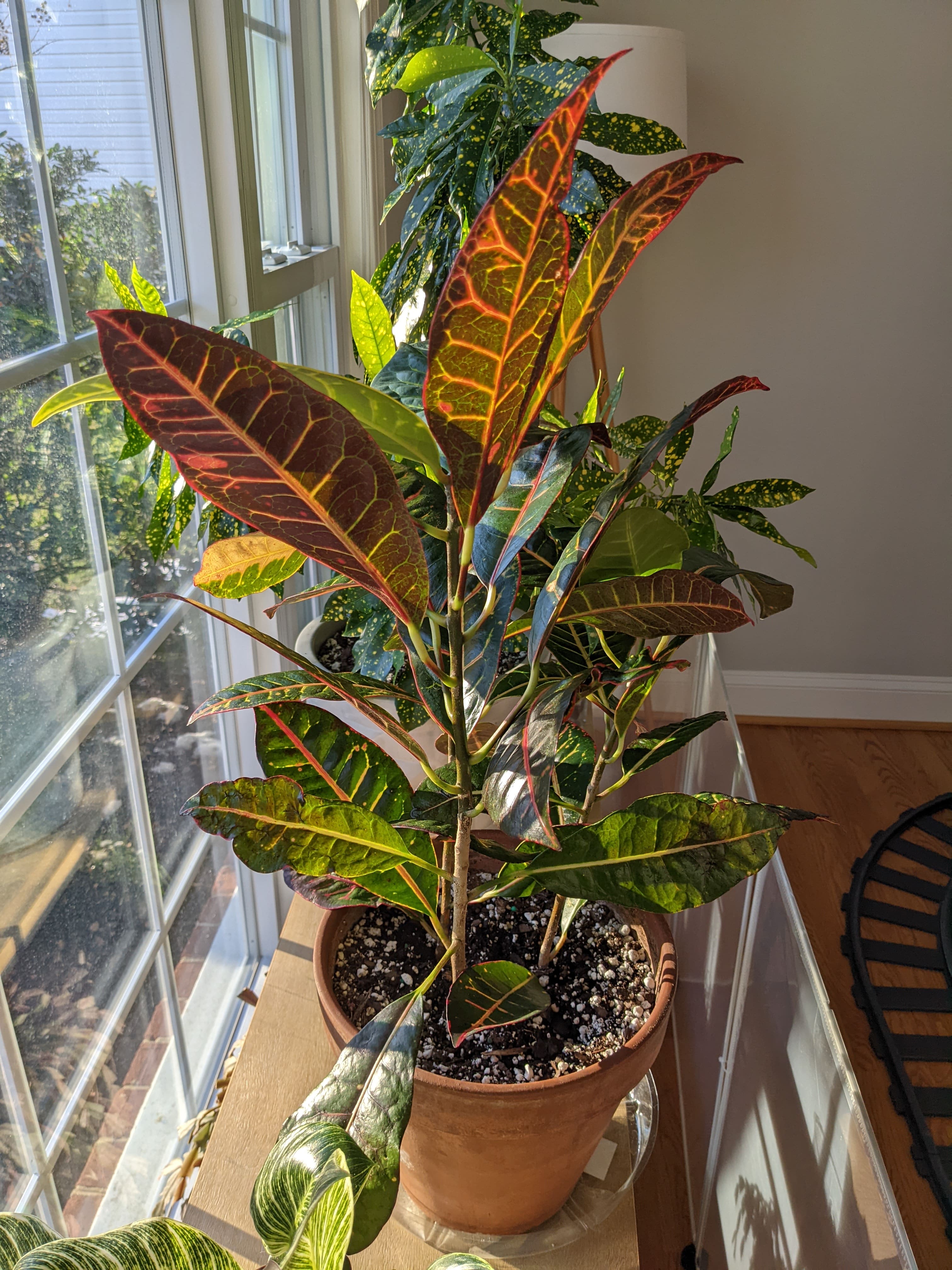Croton Petras have fabulous-looking leaves. They are extremely ornate with multi-color veins and spots. So it can a little disconcerting to find your Croton Petra leaves drooping. Do not fear though. Croton Petras can have a flair for the dramatic. I’ll discuss the most common causes of Croton Leaves drooping and tell you what you can do to fix it.
Water Issues Can Cause Drooping Leaves
Both over and underwatering can cause your Croton Petra to have drooping leaves. First, you need to figure out if you’re overwatering or underwatering. You should be able to tell by sticking your finger in the soil about a knuckle deep. If it feels wet (not just moist), then you may have overwatered. If it feels dry you may be underwatering. For me, the best way to tell if there are water issues is to use a soil moisture meter. Something simple like this soil moisture meter will do the trick.

I sometimes end up underwatering my Croton Petra. Crotons are actually pretty good at visibly drooping when they need water. A good visible sign like this helps you catch underwatering before it becomes too big of a problem. See a before and after below.


How to Fix Water Issues
If you are underwatering, it’s pretty straightforward. Water your plant. Don’t overdo it though, you could go too far the other way. If the water just runs through your plant because it was previously underwatered, you may need to water from the bottom. That just means to stick your plant pot in a bowl or the sink with water and the soil and roots soak up water from the base of the plant.
If you have overwatered, it’s more complicated. The first thing you need to do is remove your Croton Petra from its pot. That will let the root ball and soil dry more quickly. Once the root ball has dried enough to handle without completely mushing everything, you need to inspect the roots for rot. Healthy roots are white or light brown and firm. Rotten roots appear brown, feel mushy, and might smell. If you have rotten roots you need to cut them away with a clean sharp knife. Then you can repot your Croton in new soil and hope for the best. I have a whole post dedicated to fixing an overwatered plant if you want to follow along in more detail.
Fertilizing Issues Can Cause Droopy Leaves
Just like you can over and underwater, you can also over and under fertilize. Overfertilized plants are more likely to exhibit slow growth and maybe wilting or drooping, but don’t rule out under fertilizing. Typical houseplant fertilizers have a balanced ratio of nitrogen, phosphorous, and potassium, or n-p-k, which you see on the label of plant fertilizer. Nitrogen is the nutrient for healthy leaf growth, phosphorous is for blooming/fruiting, and potassium is a more all-around plant health nutrient. So you’re most likely looking for nitrogen or potassium issues.
Fertilization issues should affect all the leaves on the plant equally. Other signs that you have a fertilization issue can be slow growth. You can use soil rapitest which allows you to test for ph and each nutrient individually. It’s the only way to be totally sure you have a nutrient deficiency, and if you have a lot of plants it’s a good investment.

How to Fix Fertilization Issues
If you have overfertilized your Croton Petra, the best thing to do is to try to flush the soil by watering it a lot. You may even want to remove the plant from its pot because you don’t want to end up overwatering either.
To fix an under fertilized plant you will need to fertilize it. Water-soluble or liquid fertilizers work best for quicker absorption. If you don’t opt for a soil rapitest that I linked earlier, it would be best to stick with a balanced fertilizer that has the same number in the n-p-k ratio. If you know from the tests that you specifically have a nitrogen or potassium deficiency, then you can find fertilizers that have higher ratios of the nutrient you need. Whatever you do, follow the instructions on the fertilizing product. Some require dilution or that you water the plant beforehand.
Pests Can Cause Leaves Drooping
A wide variety of pests can attack indoor plants. The main pests that attack foliage, causing drooping, are aphids, scale/mealybugs, spider mites, and thrips. These pests pierce your leaves to feed and ultimately destroy them. Drooping leaves from pests may appear spotty where the pests have attacked, in addition to being droopy. If you think you might have pests, the best thing you can do is a close visual inspection of your plant. Use a flashlight to help you see contrast and shadows. Pay close attention to the underside of the leaves, that’s a favorite hangout for many of these pests.
How to Fix Pest Issues
If you have pests, first quarantine your plant away from other healthy uninfested plants. Next, you’ll need a multipronged approach to address pests. The first order of business is removal. Most pests can be removed by a strong spray in the shower or with a hose. Others like scale and mealybugs require manual removal. People often use alcohol-dipped cotton swabs to remove them.
Next use an insecticide. There are organic versions like neem oil that seem to do well. I have personally used neem oil on spider mites successfully. Nonorganic insecticidal soap also works well on these pests. The most important thing to do is to repeat these steps until you do not detect pests for over a week. Pests have short lifecycles so although you don’t see them their eggs may still remain.
I hope these tips help you diagnose why your Croton Petra leaves are drooping. Let us know in the comments.

I'm a long time plant lover on the quest to happily coexist with as many plants as I can. Let's grow!
